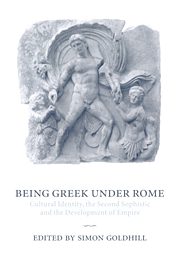Book contents
- Frontmatter
- Contents
- List of contributors
- Introduction: Setting an agenda: ‘Everything is Greece to the wise’
- 1 Subjected to Empire
- II Intellectuals on the margins
- 4 Describing Self in the language of the Other: Pseudo (?) Lucian at the temple of Hierapolis
- 5 The erotic eye: visual stimulation and cultural conflict
- 6 Visions and revisions of Homer
- III Topography and the performance of culture
- List of works cited
- Index of major passages discussed
- General index
6 - Visions and revisions of Homer
Published online by Cambridge University Press: 22 January 2010
- Frontmatter
- Contents
- List of contributors
- Introduction: Setting an agenda: ‘Everything is Greece to the wise’
- 1 Subjected to Empire
- II Intellectuals on the margins
- 4 Describing Self in the language of the Other: Pseudo (?) Lucian at the temple of Hierapolis
- 5 The erotic eye: visual stimulation and cultural conflict
- 6 Visions and revisions of Homer
- III Topography and the performance of culture
- List of works cited
- Index of major passages discussed
- General index
Summary
Prologue
It is not by chance that I begin this essay with an image of Homer from the Hellenistic period as a essential prologue to what will follow in examining his role and that of his epics in the period of the Second Sophistic. For in this chapter, I will be attempting to do two things in order to understand the remarkable cultural authority of Homer that, starting with Alexandria and the example of the notoriously philhomeric Alexander, expands so broadly over the territories of the known world under the Empire. First and primarily, I want to investigate how Homer fits into a visual culture, by which I do not mean simply any pictures of Homer or of his epics. Rather, I shall be trying to discover how a complex interlocking set of ideas about visual experience and public representation find a surprising but essential focus in Homer – or, more precisely, in the idea of Homer and his heroes. To this end, I will be using three central notions: first, theatricality – the articulation of the visual through the model of the theatre (‘the place for looking’), and through the social performances of ‘spectatorship’, ‘acting’, and ‘imitation’; second, the visual arts – how the construction of images and the scene of viewing constitute a specific intellectual and cultural arena; and, thirdly, what I call ‘close encounters’, by which I mean both the fashion for tourism to hallowed sites (in this case, focused on Troy), and, even more, particular visionary experiences of a Homeric kind, moments in which second-century intellectuals depict an uncanny sighting of a grand figure of the past, whether at the site of Troy itself or in more fabulistic contexts.
- Type
- Chapter
- Information
- Being Greek under RomeCultural Identity, the Second Sophistic and the Development of Empire, pp. 195 - 266Publisher: Cambridge University PressPrint publication year: 2001
- 36
- Cited by

